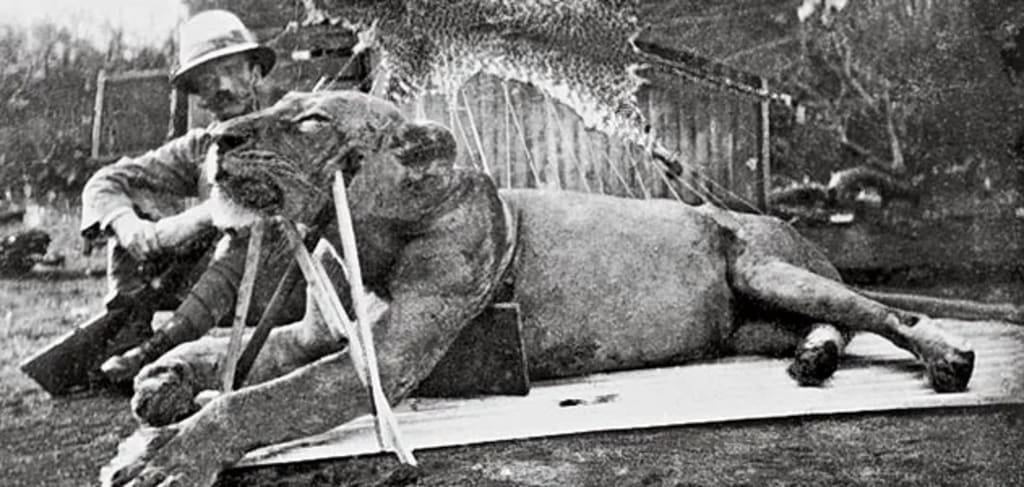MAN EATING LIONS AT TSAVO
Mystery behind tsavo man eating lions

MAN-EATING LIONS AT TSAVO
The Man-Eating Lions of Tsavo are famous at The Field Museum. The movie 'The Ghost And The Darkness' has some inaccuracies. The lions in the movie were from a zoo in Ontario and not from Kenya. The lions had beautiful manes in the film. However, the drama is based on true events. In 1898, two lions attacked railway workers in Tsavo, Kenya. Colonel John H. Patterson wrote a book about the events called "THE MAN-EATERS OF TSAVO AND OTHER EAST AFRICAN ADVENTURES". Patterson was a civil engineer assigned to build a bridge for the Kenya-Uganda railway. The lions dragged men out of their tents at night and killed them. Estimates say that 28 to 135 men were attacked over 9 months. Patterson was able to kill the lions within a few weeks of each other. He turned them into rugs and sold them to The Field Museum in 1925. The lions are now on display as taxidermy mounts
In 2009, scientists examined hairs from the pelts of two lions who were killed 111 years ago. They studied bone collagen and hair keratin values, which indicate their recent diet. The results suggest that the lions ate about 35 people, a hundred fewer than estimated by Colonel Patterson. However, the reasons behind their behavior remain unclear. Some theories propose food scarcity or a acquired taste for human flesh. Another possibility is that one lion had dental trauma that prevented it from hunting, which may have led to a change in diet. The research shows that this lion consumed 24 humans, implying that its partner consumed at least 11.
The upper right canine provides the most poetic evidence to the reshaping of the skull following this injury. Since these two were operating in pairs, why would the other one begin feeding humans if it wasn't experiencing the same kind of, say, dental disease? Since science demands that all of these theories be tried, tested, and retested, we recently had a conversation with Dr. Larisa DeSantis of Vanderbilt University. Her work focuses on the study of Pleistocene species' extinction events, such as those of saber-tooth cats. She accomplishes this by looking at dental wear patterns in animals like lions and hyenas, which are known as Microwear. Compared to African lions, hyenas consume more bones, which causes noticeable wear patterns on their teeth. However, by observing and analyzing variations in the micro-wear patterns of an African lion's teeth, significant alterations in their food source may be indicated.She was intrigued because, if the Tsavo lions were so desperate to eat human bones, it would mean that they were unable to get their usual prey, which is what led them to turn to humans. [Larisa] Therefore, one of the things we attempt to do is comprehend the ecology of these species, while it is evident that we are unable to see their historical behaviors. Thus, we may make use of hints from both the specimens themselves and from today, and one thing we can do is examine their teeth.In essence, the micro-wear will record the animal's diet for the previous few days to weeks of its life, giving us an idea of whether it was consuming a lot of flesh or something more generalized, like modern lions, or if it was primarily focused on consuming a lot of bones, similar to hyenas. Prior to doing this, we must first conduct a real study of living modern mammals that we can watch and understand their behaviors. When we correlate that known eating behavior, we can use it as a kind of contemporary baseline to evaluate what ancient creatures were doing in the past. This allows us to ask questions like: Were there particularly difficult times toward the end of the Pleistocene before the animals became extinct? Were many of these animals and humans in some form of competition over prey resources? Before they went extinct, were they eating desperately at carcasses? Consequently, we are able to examine and even refute some of those theories.However, the reason the Tsavo Lions attract us in this instance is that their nutrition differed noticeably from other They were lions that ate people. They were people. Yes, exactly, Among the queries are: what caused that? There are historical reports of people crushing bones and other things. Was it that they were a little bit desperate then? Drought occurrences and a decline in the prey base could have been the cause. Could you explain to us how you come to have one of these impressions? Yes. Thus, cleaning the teeth must be our first priority.After letting them dry, we use a dental impression material that will combine with them to create a mold, which we then have to wait for to solidify before removing. [Emily] In actuality, a dentist would utilize this. Do you say anything like, "Hey, I'm a zoologist or paleontologist and I want to get some impressions of a man eating lion," when you call the dental supplies company? Do you suppose they hear that all the time? [Larisa] I don't normally tell them, but I did tell my dentist, and he finds it amusing. and after we return to Vanderbilt, we'll actually wrap the mold itself with a small amount of putty so that we can.We can actually view the tooth at a 100x magnification, even higher, and the epoxy is able to catch all of the minute intricacies of the original tooth, creating a perfect reproduction of the tooth. [Emily] Whoa! [Larisa] and measure it in three different ways. [Emily] Is it true that we won't discover the answer to this urgent question today? [Larisa] No, it will require some time. Finding out what they were, what they were eating, or how they were acting is always the most enjoyable aspect of the work. Yes, Either millions of years ago or in 1898. Even though these lions have been dead for more than a century, we can still explore the questions of what drove them to take the behaviors they did in the last few months of their lives.[Bruce] It's incredible that, 117 years after their passing, we can still be discussing things like how many people they consumed and behavioral differences between two animals based only on a skin and a skull in a museum collection. When you consider the hundreds of thousands of specimens downstairs and the stories they have to tell, you realize how little time and manpower we have to fully explore these specimens. [Emily] Yes. [Bruce] The worth of exhibits in museums is simply enormous. [Theme from Brain Scoop] The Field Museum and The Harris Family Foundation make The Brain Scoop possible. Research by Larisa DeSantis is funded by the National Science Foundation. It still contains brains.
About the Creator
Enjoyed the story? Support the Creator.
Subscribe for free to receive all their stories in your feed. You could also pledge your support or give them a one-off tip, letting them know you appreciate their work.
Reader insights
Nice work
Very well written. Keep up the good work!
Top insight
Excellent storytelling
Original narrative & well developed characters






Comments (7)
This article impresses me; it's well-written and full of valuable information.
Thank you so much Manikandan ,will be releasing more content
KEEP IT UP
VERY INTERESTING
SUPERB STORY
VERY GOOD
GOOD